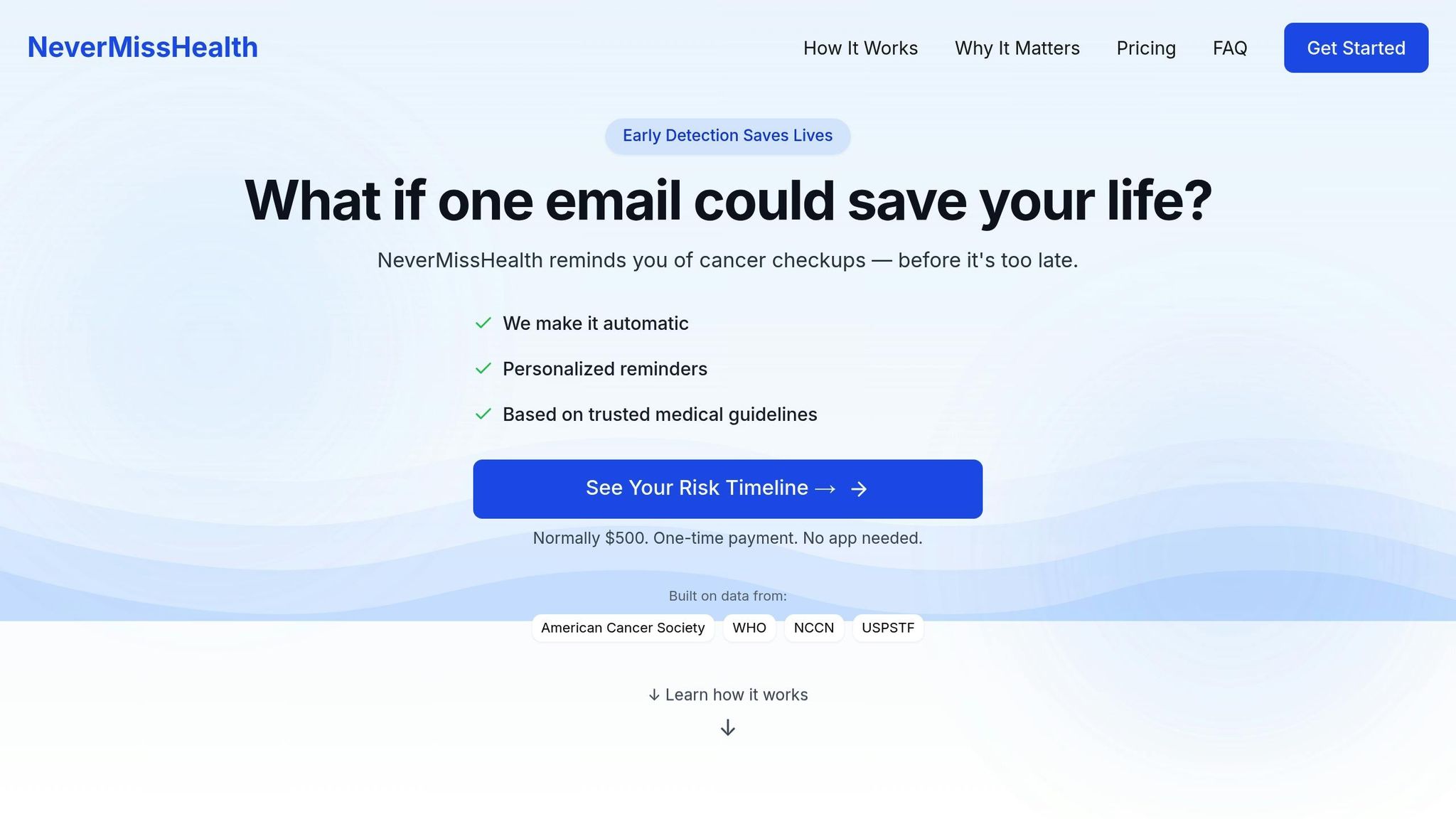
Cancer Screening Guidelines: 2025 Updates
The 2025 cancer screening guidelines focus on personalized screening plans based on individual risk factors like age, genetics, family history, and lifestyle. This replaces the older, one-size-fits-all schedules. Key updates include:
- Risk-Based Screening: Recommendations now vary by risk level - average, elevated, or high risk.
- Cancer Types Covered: Updates apply to breast, cervical, colorectal, lung, and prostate cancer screenings.
- New Screening Schedules: High-risk individuals may start earlier and screen more often.
- Insurance Coverage: Preventive screenings are generally covered, but follow-up tests may involve out-of-pocket costs.
Why It Matters
Personalized screening aims to improve early detection while minimizing unnecessary procedures. Work with your healthcare provider to create a screening plan tailored to your needs.
For easy tracking, tools like NeverMissHealth can help you manage appointments, reminders, and results in one place.
Next Step: Talk to your doctor to determine your risk level and set up your personalized 2025 screening schedule.
American Cancer Society release 2025 Cancer Report

2025 Cancer Screening Changes
In 2025, cancer screening guidelines will see updates in intervals, age recommendations, and screening methods for breast, cervical, colorectal, lung, and prostate cancers. These changes are based on the latest research, advancements in technology, and a move toward more tailored, risk-based approaches. Here’s a quick breakdown of the key updates for each type of cancer.
Risk-Based Screening Guide
Screenings should be adjusted based on your personal risk factors, as outlined in the cancer-type updates above.
Risk Level Categories
There are three main risk categories: average, elevated, and high risk. These levels are determined by various factors, including family medical history, genetic mutations, personal health history, lifestyle habits, and other individual considerations.
Screening Schedule by Risk Level
For individuals at higher risk, screenings typically begin earlier and occur more frequently. The chart below outlines the recommended screening intervals for each risk level.
Risk Level Comparison Chart
sbb-itb-f369abd
Following Your Screening Schedule
After setting up your 2025 risk-based screening schedule, keeping track of appointments is key to catching potential issues early.
Benefits of NeverMissHealth:

- Effortlessly add appointments to your digital calendar, including date, time, and location.
- Get automated email reminders ahead of each screening.
- Keep all your test details - dates, results, and follow-up steps - organized in one spot.
Staying on Top of Your Plan:
- Adjust your schedule as guidelines evolve.
- Track both upcoming and completed screenings using your log.
- Sync your schedule directly with your calendar for easy access.
Common Questions: 2025 Guidelines
Insurance and coverage questions come up often - here’s a breakdown of what you should know.
Insurance Coverage Updates
Private & Medicaid Plans: These typically cover recommended preventive screenings without any out-of-pocket costs [1].
Medicare: Medicare fully covers recommended screenings when done by a participating provider. For specific details, call 1‑800‑MEDICARE [2].
- You might face out-of-pocket costs for diagnostic follow-ups, such as after polyp removal [3].
- Colonoscopies for high-risk individuals under 45 may involve deductibles, coinsurance, or copays [3].
- Medicaid benefits vary by state, so check your local coverage [2].
Determining Your Risk Level
To figure out your screening needs, talk to your healthcare provider. They’ll help you evaluate your risk factors and create a personalized screening schedule.
- Your provider will use established guidelines, like those from the National Comprehensive Cancer Network (NCCN), to recommend the best screening plan for you.
Next Steps for 2025
With your risk-based schedule ready, here’s how to move forward with your 2025 plan.
Use your risk level worksheet to organize key details like family history, previous results, lifestyle factors, and any questions you have. Bring this information to your healthcare provider, who can help tailor and adjust your screening plan to fit your needs.
Let NeverMissHealth handle reminders and keep track of your results. The platform syncs with your calendar and keeps a record of your screening history for easy access.
Get started now to make the most of the advancements in early detection for 2025.